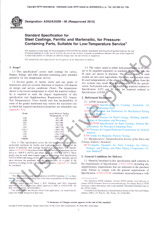We need your consent to use the individual data so that you can see information about your interests, among other things. Click "OK" to give your consent.
ASTM D8446-22
Standard Test Method for Water Vapor Content in Compressed Air Using Electronic Moisture Analyzers
Translate name
STANDARD published on 1.6.2022
The information about the standard:
Designation standards: ASTM D8446-22
Publication date standards: 1.6.2022
SKU: NS-1069734
The number of pages: 7
Approximate weight : 21 g (0.05 lbs)
Country: American technical standard
Category: Technical standards ASTM
Annotation of standard text ASTM D8446-22 :
Keywords:
dew point, humidity, hygrometer, temperature, vapor pressure dew point,
Additional information
| Significance and Use |
|
5.1?Water vapor is ubiquitous and a basic contaminant in compressed air. It cannot be eliminated but shall be controlled. Knowledge of the vapor content of compressed air is important for industrial processes to ensure that compressors that generate compressed air are functioning properly and equipment and systems that use the compressed air will function properly and maintain high reliability. This test method describes the measurement of water vapor using direct readout electronic instrumentation. Measurements are provided as dew point/frost point and calculations of related unitless quantities (ppm) are provided. Sampling techniques and warnings are provided to reduce false readings caused by contamination from the sampling method. Dry compressed air typically has a frost point between 80 ?C and 40 ?C (0.5 PPM5.2?Measurement of moisture in compressed air can be done after regulating the pressure down to ATM or measured at elevated pressure up to the full system pressure. When measurements are made of the actual dew point (for example, condensation) or the related property of vapor pressure, the value of the dew point (and vapor pressure) is directly affected by the sample pressure since the vapor pressure is a component of the total pressure. The relationship between vapor pressure and moisture content (and dew point) is well defined below 5 MPa, but at greater pressures, additional study needs to be done to define this relationship. 5.3?Electronic moisture analyzers are also used for measuring moisture levels in other gases, including gaseous fuels. See Test Method D5454. In addition, tunable diode laser spectroscopy (TDLAS) is another technology that may be applicable to detecting moisture in compressed air. This technology is already being used in gases. See Test Method D7904. |
| 1. Scope |
|
1.1?This test method covers the determination of the water vapor content in compressed air using portable or in-situ electronic moisture analyzers. Such analyzers commonly use sensing cells based on phosphorus pentoxide, P2O5, aluminum oxide, Al2O3, or silicon piezoelectric-type cells or laser-based technologies. 1.2?This test method is applicable for the range of condensation temperatures from 80 ?C to 60 ?C. 1.3?Testing is often performed at reduced pressure from the full pressure of the system or source of compressed air depending on the capability of the specific analyzer. Testing above 2000 kPa may introduce additional uncertainty because of changes in the relationship between water vapor pressure and actual moisture content at elevated pressures. 1.4?UnitsThe values stated in SI units are to be regarded as the standard. No other units of measurement are included in this standard. 1.5?This standard does not purport to address all of the safety concerns, if any, associated with its use. It is the responsibility of the user of this standard to establish appropriate safety, health, and environmental practices and determine the applicability of regulatory limitations prior to use. 1.6?This international standard was developed in accordance with internationally recognized principles on standardization established in the Decision on Principles for the Development of International Standards, Guides and Recommendations issued by the World Trade Organization Technical Barriers to Trade (TBT) Committee. |
We recommend:
Technical standards updating
Do you want to make sure you use only the valid technical standards?
We can offer you a solution which will provide you a monthly overview concerning the updating of standards which you use.
Would you like to know more? Look at this page.




 Cookies
Cookies
